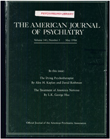Falret's discovery: the origin of the concept of bipolar affective illness. Translated by M. J. Sedler and Eric C. Dessain
Abstract
Jean Pierre Falret's once celebrated but now neglected 1854 description of "circular insanity" has not been translated into English until now. This seminal essay clearly articulated for the first time the rudimentary elements of our present diagnosis of bipolar affective disorder. It contains lucid descriptions of manic excitement and depression and the "switch" from one to the other; moreover, it emphasizes the importance of course and prognosis, as well as hereditary and epidemiologic factors. Although American psychiatry instinctively looks to the German literature for its foundations in Kraepelin, Bleuler, and Freud, the translation of Falret's essay represents an effort to trace contemporary psychiatric concepts to their origins in nineteenth-century France.
Access content
To read the fulltext, please use one of the options below to sign in or purchase access.- Personal login
- Institutional Login
- Sign in via OpenAthens
- Register for access
-
Please login/register if you wish to pair your device and check access availability.
Not a subscriber?
PsychiatryOnline subscription options offer access to the DSM-5 library, books, journals, CME, and patient resources. This all-in-one virtual library provides psychiatrists and mental health professionals with key resources for diagnosis, treatment, research, and professional development.
Need more help? PsychiatryOnline Customer Service may be reached by emailing [email protected] or by calling 800-368-5777 (in the U.S.) or 703-907-7322 (outside the U.S.).



